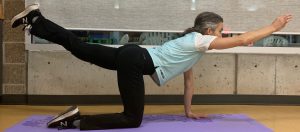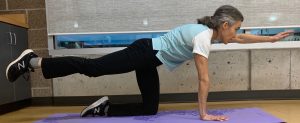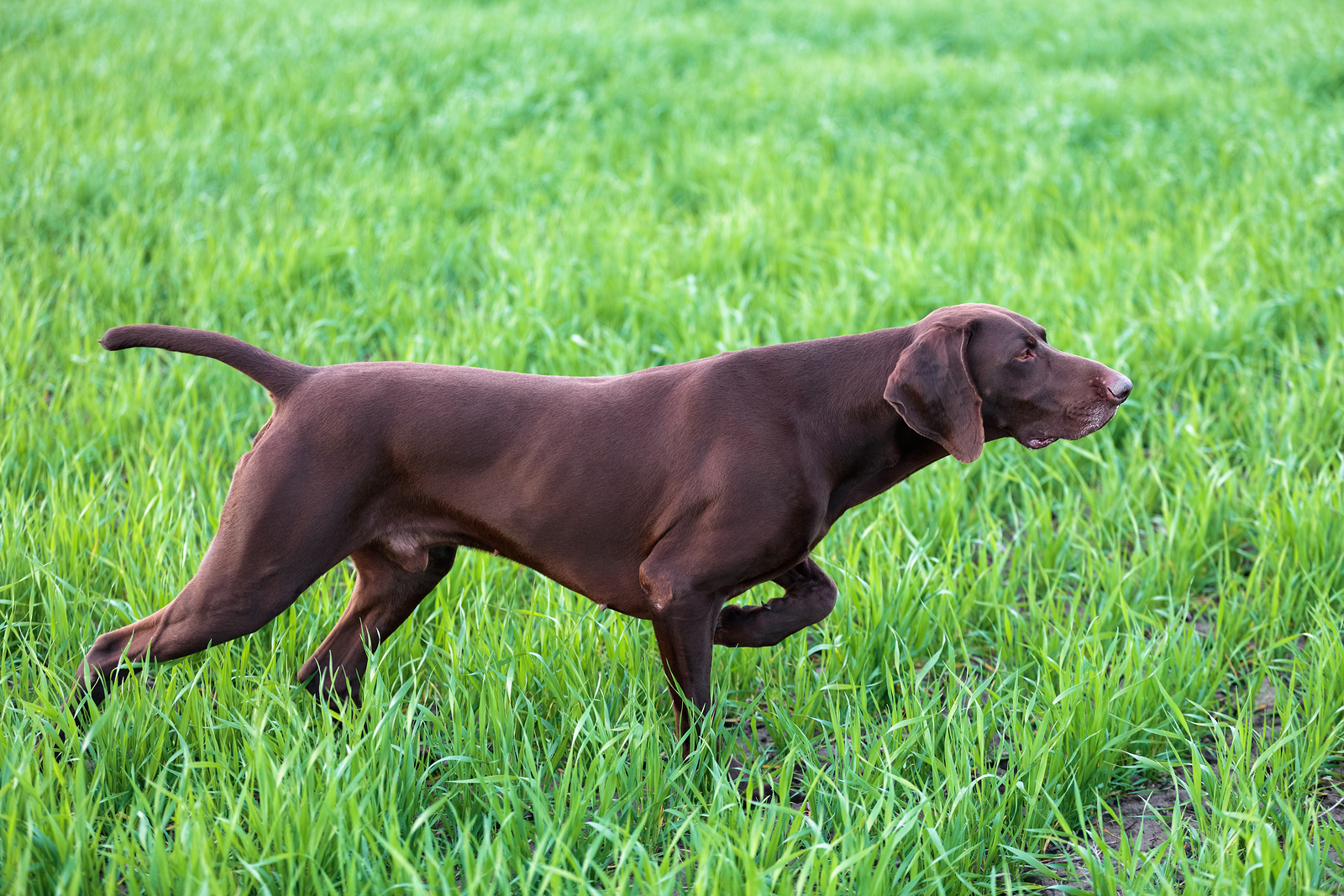Although Bird Dog is an excellent exercise for strengthening the back and glutes, most people do it wrong. I counted three people performing the movement incorrectly during my short one-hour gym workout last week! Thus, I was inspired to write this blog.
The Problem
Here it is. Look at the first photo. In this example, I am overextending the lumbar spine and using the back to extend the hip. Instead, I should be using my glutes to extend the hip!

If you do this correctly, the Bird Dog exercise strengthens the back extensor muscles that are positioned along the left and right sides of the spine and run all the way from the pelvis up to the head. These muscles straighten the back and assist in rotation, which makes them important for posture and performance. In the picture above, I am overextending these muscles. As a result, I have lost any hope of spinal stability.
Stuart McGill, PhD, a world-renowned expert on back issues, includes Bird Dog in his “big three” for back stabilization exercises. However, to be effective, he emphasizes that the spine needs to remain neutral throughout the movement. To do this, you must coactivate your abdominals with the back extensors. McGill calls this “abdominal bracing.” In the image above, the abdominals are not engaged. They’re overstretched and long. Also, the spine is not neutral; there’s way too much arch in the lower back.
The Solution
In order to do this correctly, engage your abdominals, maintain a neutral spine, and extend your hip with your glutes:

Although I am not a perfect model, this image demonstrates a more neutral spine with coactivation of the muscles on the front (abdominals) and back (extensors) of the torso. In other words, think of doing a small abdominal crunch in this position in which you’d tilt your rib cage and pelvis toward each other. Also, notice my lower back. It is in a longer, straighter position than the first picture. Finally, notice that my leg is much lower than in the first photo. Since my torso is tightened, I cannot raise my leg as high.
Mike Boyle, an internationally acclaimed strength and conditioning expert, states that the heel should never go above the butt when doing Bird Dog. High leg position and excessive arch in the low back are the giveaways of incorrect form.
This lower leg position helps me to engage the glutes for hip extension. The Bird Dog is one of my “go to” exercises for teaching someone how to extend the hip using the glutes. In the Bird Dog exercise, the hip starts in a flexed position, with the knee on the ground directly underneath the hip, and extends as the leg moves behind the body and the knee straightens.
The top picture shows a dramatic curve in the low back. This shows an incorrect use of the back to extend the hip behind. If you increase the arch in the lower back, you can move your leg behind you. However, you should be using the gluteal muscles to do the work, not your back. The glutes will only engage if the lumbar spine stays neutral.
NOTE: This movement pattern (using the back instead of the glutes to extend the hip) is a common cause of back pain. When you take a step, notice your movement. If you are moving your leg behind you by pivoting at your back instead of engaging your glutes, your back can quickly become painful.
Are you including Bird Dog in your workouts? Give it a try today!
_____________________________________________________________________________
McGill, S. M. (2007) Low Back Disorders Evidence-Based Prevention and Rehabilitation (2nd ed.). Champaign, IL: Human Kinetics.
Boyle, M. (2018) Complete Core Online Course. Retrieved from: http://completecoreaa.com/ If you do this correctly, the Bird Dog exercise strengthens the back extensor muscles that are positioned along the left and right sides of the spine and run all the way from the pelvis up to the head. These muscles straighten the back and assist in rotation, which makes them important for posture and performance. In the picture above, I am overextending these muscles. As a result, I have lost any hope of spinal stability.
Stuart McGill, PhD, a world-renowned expert on back issues, includes Bird Dog in his “big three” for back stabilization exercises. However, to be effective, he emphasizes that the spine needs to remain neutral throughout the movement. To do this, you must coactivate your abdominals with the back extensors. McGill calls this “abdominal bracing.” In the image above, the abdominals are not engaged. They’re overstretched and long. Also, the spine is not neutral; there’s way too much arch in the lower back.
The Solution
In order to do this correctly, engage your abdominals, maintain a neutral spine, and extend your hip with your glutes:
If you do this correctly, the Bird Dog exercise strengthens the back extensor muscles that are positioned along the left and right sides of the spine and run all the way from the pelvis up to the head. These muscles straighten the back and assist in rotation, which makes them important for posture and performance. In the picture above, I am overextending these muscles. As a result, I have lost any hope of spinal stability.
Stuart McGill, PhD, a world-renowned expert on back issues, includes Bird Dog in his “big three” for back stabilization exercises. However, to be effective, he emphasizes that the spine needs to remain neutral throughout the movement. To do this, you must coactivate your abdominals with the back extensors. McGill calls this “abdominal bracing.” In the image above, the abdominals are not engaged. They’re overstretched and long. Also, the spine is not neutral; there’s way too much arch in the lower back.
The Solution
In order to do this correctly, engage your abdominals, maintain a neutral spine, and extend your hip with your glutes:
 Although I am not a perfect model, this image demonstrates a more neutral spine with coactivation of the muscles on the front (abdominals) and back (extensors) of the torso. In other words, think of doing a small abdominal crunch in this position in which you’d tilt your rib cage and pelvis toward each other. Also, notice my lower back. It is in a longer, straighter position than the first picture. Finally, notice that my leg is much lower than in the first photo. Since my torso is tightened, I cannot raise my leg as high.
Mike Boyle, an internationally acclaimed strength and conditioning expert, states that the heel should never go above the butt when doing Bird Dog. High leg position and excessive arch in the low back are the giveaways of incorrect form.
This lower leg position helps me to engage the glutes for hip extension. The Bird Dog is one of my “go to” exercises for teaching someone how to extend the hip using the glutes. In the Bird Dog exercise, the hip starts in a flexed position, with the knee on the ground directly underneath the hip, and extends as the leg moves behind the body and the knee straightens.
The top picture shows a dramatic curve in the low back. This shows an incorrect use of the back to extend the hip behind. If you increase the arch in the lower back, you can move your leg behind you. However, you should be using the gluteal muscles to do the work, not your back. The glutes will only engage if the lumbar spine stays neutral.
NOTE: This movement pattern (using the back instead of the glutes to extend the hip) is a common cause of back pain. When you take a step, notice your movement. If you are moving your leg behind you by pivoting at your back instead of engaging your glutes, your back can quickly become painful.
Are you including Bird Dog in your workouts? Give it a try today!
_____________________________________________________________________________
McGill, S. M. (2007) Low Back Disorders Evidence-Based Prevention and Rehabilitation (2nd ed.). Champaign, IL: Human Kinetics.
Boyle, M. (2018) Complete Core Online Course. Retrieved from: http://completecoreaa.com/
Although I am not a perfect model, this image demonstrates a more neutral spine with coactivation of the muscles on the front (abdominals) and back (extensors) of the torso. In other words, think of doing a small abdominal crunch in this position in which you’d tilt your rib cage and pelvis toward each other. Also, notice my lower back. It is in a longer, straighter position than the first picture. Finally, notice that my leg is much lower than in the first photo. Since my torso is tightened, I cannot raise my leg as high.
Mike Boyle, an internationally acclaimed strength and conditioning expert, states that the heel should never go above the butt when doing Bird Dog. High leg position and excessive arch in the low back are the giveaways of incorrect form.
This lower leg position helps me to engage the glutes for hip extension. The Bird Dog is one of my “go to” exercises for teaching someone how to extend the hip using the glutes. In the Bird Dog exercise, the hip starts in a flexed position, with the knee on the ground directly underneath the hip, and extends as the leg moves behind the body and the knee straightens.
The top picture shows a dramatic curve in the low back. This shows an incorrect use of the back to extend the hip behind. If you increase the arch in the lower back, you can move your leg behind you. However, you should be using the gluteal muscles to do the work, not your back. The glutes will only engage if the lumbar spine stays neutral.
NOTE: This movement pattern (using the back instead of the glutes to extend the hip) is a common cause of back pain. When you take a step, notice your movement. If you are moving your leg behind you by pivoting at your back instead of engaging your glutes, your back can quickly become painful.
Are you including Bird Dog in your workouts? Give it a try today!
_____________________________________________________________________________
McGill, S. M. (2007) Low Back Disorders Evidence-Based Prevention and Rehabilitation (2nd ed.). Champaign, IL: Human Kinetics.
Boyle, M. (2018) Complete Core Online Course. Retrieved from: http://completecoreaa.com/


